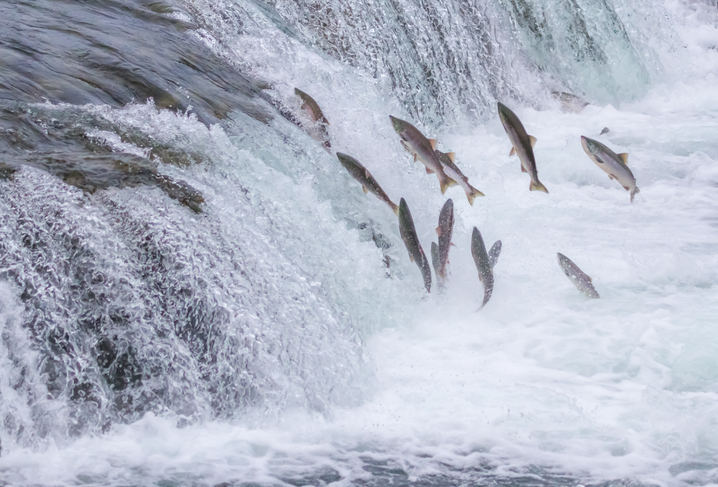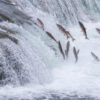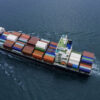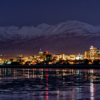Alaska’s Iconic Salmon: Migration Economic Impact
Every year, millions of salmon embark on one of nature’s most awe-inspiring journeys—the salmon run. This is when salmon make their way from the ocean back to the freshwater rivers and streams where they were born, all to lay eggs and complete their life cycle. It’s an incredible natural event that keeps the salmon population thriving and plays a huge role in Alaska’s ecosystem, economy, and culture.
Meet Alaska’s Salmon: Five Key Players
Alaska is home to five species of wild Pacific salmon, each with unique traits. King salmon, also known as Chinook, are the heavyweight champions of the salmon world, sometimes weighing over 100 pounds. Sockeye salmon, or red salmon, are famous for their deep red flesh and bold flavor, making them a top choice for smoking and canning. Coho salmon, also called silver salmon, are a favorite among sport fishers because of their aggressive fight and delicious meat. Pink salmon, or humpy salmon, are the most abundant species, often used for canned salmon and roe. Lastly, chum salmon, also known as dog salmon, are prized for their firm flesh and valuable roe, which are often exported worldwide.
When to Fish and What Visitors Need to Know
First of all, for a successful fishing trip for salmon, you have to know when to go, timing is everything! Salmon runs happen at different times depending on the species, but generally, the peak season is May through September:
- King Salmon: May to July
- Sockeye Salmon: June to August
- Coho Salmon: July to September
- Pink Salmon: Mid-June to late July
- Chum Salmon: June to August
Before you grab your fishing rod, make sure you’re following Alaska’s fishing regulations:
- You’ll need a fishing license, and if you’re after king salmon, a special king salmon stamp.
- Follow daily bag and possession limits to help keep the fish population sustainable.
- Some areas have catch-and-release rules, so check before you fish.
- Regulations can change based on conservation needs, so always check for updates from the Alaska Department of Fish and Game.
For visitors, guided fishing trips and lodges are a great way to experience salmon fishing while making sure you stay within the rules. Learning and respecting the regulations helps keep Alaska’s salmon fisheries thriving for generations to come.
How Salmon Impact Alaska’s Economy
Salmon fishing isn’t just a pastime in Alaska—it’s a way of life. The fishing industry is a significant economic driver, supporting thousands of jobs and generating billions annually. Alaska supplies nearly 60% of all wild-caught seafood in the U.S., with salmon leading the pack. The Alaska salmon industry generates over $1.5 billion in economic value annually. More than 40,000 jobs depend on Alaska’s salmon fisheries, including commercial fishers, processors, and exporters. Additionally, Alaska exports over 200 million pounds of salmon annually, shipping fresh and frozen fish to markets worldwide.
Sustenance Fishing in Alaska
In addition to commercial and sport fishing, subsistence fishing is important in Alaska, particularly for Indigenous and rural communities. This form of fishing is primarily for personal or community eating rather than for sale. Subsistence fishing is crucial to food security, especially in remote areas where store-bought food can be scarce and expensive. Alaska residents in designated rural areas can practice subsistence fishing using traditional methods like dip nets and gillnets. These practices are regulated to ensure sustainability and allow for a continued harvest of salmon, providing a vital food source while preserving cultural traditions.
Cool Facts About Alaska’s Salmon Industry
- The world’s largest wild salmon fishery is in Bristol Bay, Alaska, with over 50 million fish returning annually.
- Alaska has some of the world’s strictest sustainable fishing laws to help keep salmon populations healthy.
- Sport fishing is a major tourism draw, bringing in millions of dollars each year from anglers around the world.
- Salmon are deeply woven into Alaskan Native traditions, playing a vital role in diets and cultural practices.
The salmon run isn’t just an incredible natural event; it’s a large portion of Alaska’s fishing industry and a key part of its economy. Thanks to sustainable practices and conservation efforts, Alaska is still one of the best places in the world for wild salmon. Whether you’re a commercial fisher, a sport angler, or just someone who enjoys a salmon meal, these fish have made Alaska what it is today.
Need urgent commercial fishing supplies? Alaska Air Forwarding offers quick, reliable air freight services to make sure your fishing operations stay on track, from engine parts to gear boxes. Call 800-426-0004 or get a quote online to get started today!






